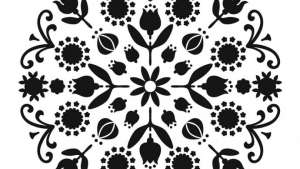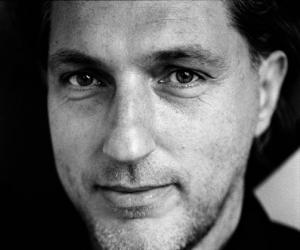From the Series
First Published in
Once upon a time there was a young man who went to Eindhoven Design Academy. It was written in the stars: He would be a designer. But disaster struck when an evil professor flunked him out of the school and the young man was banished to labour in the provinces among the jewellers and craftspeople of Maastricht.
The young man was very determined to succeed however and worked doubly hard at not only impressing his teachers but also doing his own interpretations for his personal advancement. By the time the young man had finished his studies, he was spoken of across the land in competitions, exhibitions and magazines.
Now, some 20 years on, the man has come to be known as one of the world’s hottest designers – not only for his humorous, fantastical theatricalities but, well, for himself. Infamously his girlfriend has poured champagne for guests at an opening while swinging from a chandelier, he has amassed over 40 speeding tickets in Amsterdam, stripped down to his birthday suit in presentations such as the Naked Designer and named his daughter Joy Faith Love Wanders.
In the vein of modern artists such as Salvador Dalí and Marcel Duchamp, Marcel Wanders himself is a work of design. “Fabulous!” he says.
Nadine Botha: You say you design from mentality. What does that mean?
Marcel Wanders: A lot of designers work from a strictly stylistic point of view or they have some fundamental idea about how they want their shapes to be. I work from a mentality in that there is an endless vocabulary of form, but still my work is recognisable because it has a mentality – it is something that you can feel. There is a mood and personality behind the work. Perhaps personality is a better word than mentality: it’s a personal logic.
Is it your personality?
Yes, yes I have to move the ship, so it’s driven by me. But there’s a logic behind it: We [the Marcel Wanders Studio] do things in a certain way, putting more import into strategy and communication than maybe other designers. It’s not strictly stylistic, which a lot of designers are. I don’t think we have that much of a style.
Is this a constructed public personality?
Yes, I think so, but it’s unavoidable. If you put your name on an object, you communicate who you are and that there is a person behind the object. Then you need not only to create a personality, but it should be a fabulous personality as well – this makes the product or family of products even more interesting. If you forget this, I don’t know why you would put your name on something. People who put their name on something and then think that they should be quiet, do wrong.
You in particular seem to embrace a “rock star” lifestyle, while many other designers seem rather staid and even preppy. Is it expected that designers be conservative – maybe to match their minimalist work – and are you consciously challenging that?
If you put your name on an object, you are responsible for the content of the person behind the object. And that has to be fabulous – you design the object, the design and the person behind it all. If your products are boring and you are a boring designer, that’s fine, I understand, but then there’s no reason to put your name on the product because it just won’t get any better. To make exciting products, you have to be an exciting person – there should be a consistency with who you are and what you deliver. For me, I am just me – it is theatrical because I like to live my life in an exciting way. I dunno, it’s who I am. What can I do?
Even more than your name, your Airborne Snotty Vases must be your most notorious work. How and why did you come across running airborne boogers through a 3D scanner?
The Airborne Snotty Vases was a project that started from a theoretical basis in that I really wanted to study digital scanning technology because it promised to make things possible that were otherwise completely impossible. I am sure that this technology will win a space in the future because it is so unique – you can do things that are completely free in form. So I wanted to study what it would be used for in the future.
This became a challenge to not only design something with my mind, but to find something that was really spectacular and had never been seen before. So instead of making a shape, we tried finding a shape that was already there but had never been seen. At some point while we were thinking, someone sneezed and I thought to myself that it was a very interesting action – we do it all the time and we don’t know what we create. So we decided to find out by looking through a 3D scanner, where we were able to capture a fantastic form and then replicate the form to produce an object.
I think this is nice – by using this incredibly new and advanced technique, we were able to find and create very advanced shapes. But also, I think it’s nice when things are beautiful as well as ugly. It’s interesting to me that people sometimes like the vases until I tell them it’s a virtual airborne snotty. It’s important that the things we do touch people – whether they hate it or they love it.
Is that what you mean when you talk about how the industrial age has seen designers “celebrate the poor possibilities of the available machinery”? (In the introduction to 21st Century Design by Marcus Fairs.)
For 100 years, designers have been listening to machines when making something for people, whereas I think that they should listen to people and then use machines to make something. We should be humanist instead of technocrats. If I use a machine technique to make something that is unimportant to people, that’s terrible.
I think that we are born to live our lives as princes and princesses, and I feel that we can rise to this position if we use technology in the right way. But we have to start with thinking that we deserve to live a fabulous life and that it is not impossible to do, but entirely technically feasible. I mean, technology like 3D photography can make crazy, beautiful dreams come completely true. And that’s not thanks to technology, but because humans love to create dreams and poetry.
Is realising these crazy, beautiful ideas what informs your rejection of environmental design in preference for durability?
There’s a lot to be said about environmental concerns and, of course, we all think about it in different ways. One of the ways that we concern ourselves with is through durability, which is a way to create objects that people will never throw away because they are so important to them. This is good for the environment and humanity. In creating durability, I started thinking differently to the rest of the design world a long time ago.
Let me tell you a story. A long time ago, about 15 years ago, there was a group of people called Eternally Yours that I was involved in. The focus was on new ways to create more durability. At one point there was a girl who created a velour fabric – the type where the hair stands right up. In the velour that she developed, a floral pattern would appear when the hair wore off. Everyone was excited. But I was not so excited because I thought that what she was saying to the audience is that the normal wearing of velvet is not right, beautiful or a good thing. This made me realise that instead of durability being a material problem, it was a psychological problem.
In our culture, the words “old” and “new” have completely different importance. We really love the new and are afraid of the old. The strange coincidence is that it is designers who create the new world and who are, even more than the average people in the street, excited about the new. These people create objects with metaphors of the new, forgetting the metaphors of the old. The first scratch on this object would be seen as its first sign of deterioration, which is a negative thing. I call this the “baby face fixation” – wanting everything to be clean, beautiful and new.
Instead, I decided from that moment that every project I do, every object I make, will always have the metaphor of the old and the metaphor of the new. So it will always be in between my father and my daughter – and that’s my face. I want to be in this position to make sure that the objects I make will not be thrown out fast, instead living a long, durable life. For me it’s an important way to address environmental concerns, as well as create objects that are more meaningful to people.
Durability in terms of material is quite defined, but what about in terms of style, where people’s aesthetic tastes change much faster?
I think it’s important to change, but everything moves in waves and the wavelength is very different for certain objects. This is fine; we have the need for change and the need for durability. So perhaps if you buy a postcard, it feels very new and it will be new every time you buy it. But if you buy a wedding ring, it feels very durable. See, they have different wavelengths in terms of being new or exciting. So every object has its own logic. I like to make the type of object that is a durable object. For instance, we’ve made a few items of clothing now, but I would never call it fashion because I’m sure it will still be fantastic for the next 10 years, no problem.
With works like the Knotted Chair, the Fishnet Chair and the Crochet Series, you’ve taken traditional craft techniques and used technology to make them more durable. What do you think of the so-called craft debate?
What is the craft debate? I don’t know. Let’s say 20 years ago, design was industrial design. We started to make chairs and stuff that was difficult to make. For 100 years, designers have made things that are easy to make and that’s all we’ve given the world. To make something that is difficult to make is not worse or better, it’s just another way to make things and at least the end product takes effort from the maker. That’s why I’ve been working on a lot of things that involve craft.
The strange thing is that even the industrially produced furniture has tons of hand labour involved in it – it just tries to look like it’s machine made, but it’s not. In fact, if we’re talking about craft I think we have to talk about why China is the country that all the products in the world come from. It’s not because they have better machines there, it’s because they have more hands. The fact that China is the biggest producer of products proves that industrial design has completely failed. Why else is it that the country where people work with their hands all the time is the biggest producer in the world?
And I think it is a pity that we don’t show the hand labour of these people, because then we would actually feel that the products are more valuable. So I don’t think that it should be the one or the other, but that both hand and industrial production can be very interesting.
You design, promote, run a number of businesses, collaborate across the creative smorgasbord, invest in property, experiment and have a good time to boot. How do you manage to be good at everything?
I think that as a creative person you are best at what you don’t know how to do. If you have to do something new and you don’t know how to get it done, what comes out is your creativity and you find a way to do what you can’t. So I’m always going into areas that I’m completely uninvolved in and have no idea how to get it done – I will always go to this fearful place because that’s the place where I am best.
Do some roles come more naturally than others? I heard that you had to really work hard to get your degree in design after flunking out of Eindhoven.
I think that if you don’t have to work hard to get it done, you didn’t do it well. You just didn’t give enough energy for it to become fabulous. Everything you do in which you want to be fabulous, you have to give everything and more. So nothing comes easily, because it should not come easily. If it comes easily it’s not worth it.
You’ve called Philippe Starck the greatest living designer. Why don’t you consider yourself the greatest living designer?
I would love to one day live in Philippe Starck’s shadow. I think he is far beyond me and instead of me getting closer to him, I feel he is running away very fast. The man is a genius – more than anyone else in design, he is able to look at himself and what he is doing in a very open-minded way and then change it. The man has reinvented design three times in different ways and right now he is doing the same – tomorrow we will find out how far ahead he is.
You’ve been working with him and John Hitchcox from Yoo on the Mondrian in South Beach. How has that been?
No, we don’t do projects together, but work in the same field. Starck is a part-owner of the company and I work with the company. I would never work together with Philippe again – it’s terrible to work with him. He’s just as terrible as I am. And selfish – just like me. I want to do everything myself and know everything better, of course. The thing is, though, if you can do something on your own, why do it with someone else? If you can’t do it on your own, of course you do it with someone else. But I think Philippe is very capable of designing whatever he wants and, to be honest, I feel the same. So, there’s no reason to work with him – I’d rather have a drink or a great time with him.
What was the brief for the Mondrian and how did you interpret it?
The brief was to do a fabulous hotel, which would establish the Mondrian brand and be a fabulous place for Miami and the people who visit it. Of course the Morgans Group developers have their own type of client but they gave me carte blanche to do a Marcel Wanders hotel.
You know the story of Sleeping Beauty? At the moment that it ends, that’s the moment you arrive at the hotel. I wanted to create a space where people see themselves and others with new eyes; as though they’ve been sleeping for a 100 years and now wake up. It’s very a romantic place, very royal, very theatrical. We’ve played with all kinds of things to make this happen – whether it is bells in the lobby area or superhero women inviting you in. But you have to see it…
Why don’t you like being called a Dutch designer?
I design for the world. But, to be fair, I was much more sensitive about that in the past. I understand now that it’s like making a unique gift. One of the reasons I like design so much is that I liked making gifts when I was a kid. A good gift will say something about the person who gets the gift – you don’t give something that doesn’t resonate with this person, it makes no sense. Also, you hope that the gift says something about who you are, how you see this person and what you think is important in life. That is how I like to see my design – I like to make things that are both for the whole world as well as speaking about who I am. And yes, I’m Dutch. Yes, I’m born here in this country. So, if you can recognise that I’m Dutch from my work, then that’s fantastic – I hope to give something beautiful from my surroundings.



























